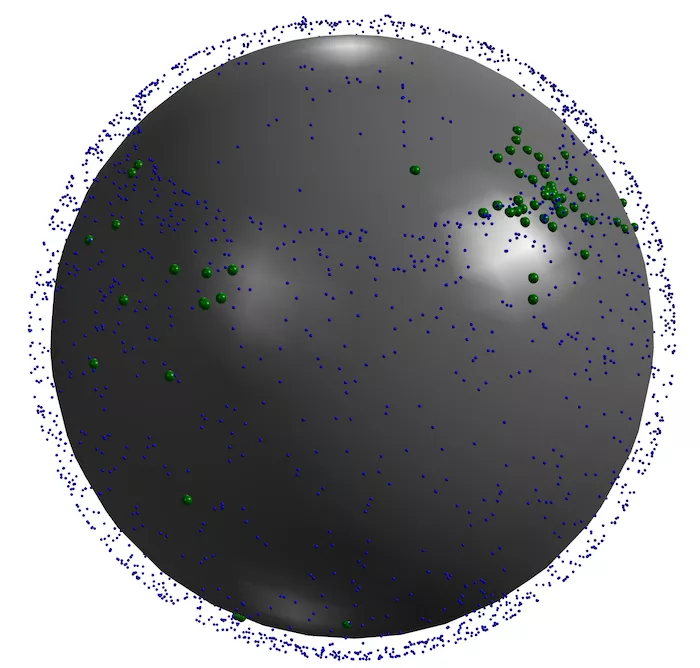
Förderjahr 2024 / Projekt Call #19 / ProjektID: 7442 / Projekt: LEO Trek
Low Earth Orbit (LEO) mega constellations provide low latency communication between LEO and terrestrial nodes and among terrestrial nodes, extending the Edge-Cloud Continuum into an Edge-Cloud-Space 3D Continuum. Developing orchestration services and applications for the 3D Continuum requires realistic simulations of the highly dynamic network conditions and node locations inherent to this environment. Unfortunately, existing simulators only allow for relatively small constellations to be simulated without scaling to a large number of host machines. Stardust is a scalable and extensible open-source simulator for the 3D Continuum. Our main contributions are:
- Stardust, a scalable and extensible next generation simulator for the 3D Continuum with support for simulating LEO-, Cloud-, and Edge nodes in a scalable manner. Stardust enables experiments for evaluating networking and orchestration algorithms for the 3D Continuum. It supports simulating mega constellations three times the size of the currently largest constellation, with almost 7k satellites on a single machine.
- A dynamic routing mechanism that enables experimentation with different routing mechanisms by making the ISL routing protocol and the network path computation changeable. This allows, e.g., changing the default +Grid ISL routing to a different protocol or to introduce caching or hypergraph algorithms as a replacement for Dijkstra's algorithm to calculate node-to-node network paths.
- SimPlugin, a plugin mechanism that serves as the integration point for custom logic that Stardust should execute at every step of the simulation. A SimPlugin has access to the complete infrastructure state and, thus, allows integrating, e.g., orchestration algorithms/software that should be evaluated using Stardust.

Stardust is designed to use a modular architecture to enable extensibility. The core abstractions are shown in Figure 8. The central type from which all 3D Continuum nodes derive is Node. Every Node has computational capabilities, communication links to other nodes, and the ability to route traffic. The abstract Node class is currently implemented by the GroundStation and Satellite subclasses, required for different behaviors in movement. For GroundStation, a simplified movement (without inclined Earth axis and exact rotation duration) along the latitude every 24 hours is implemented. Satellite calculates the position by solving Kepler’s equation for eccentric anomaly, considering only the gravitational interaction between the Earth and the satellite, i.e., it computes an unperturbed orbit. Since we focus on simulations of a few hours, this simplification helps reduce the computational complexity and hardware requirements, while providing sufficient accuracy.
To simulate the available network connections with 100% accuracy with respect to the node positions in the 3D Continuum, Stardust constructs a network graph that captures all nodes and the physical connections between them. A direct physical connection between two nodes, e.g., a cable, radio, or laser link, is modeled by a link (ILink) between those two nodes in the network graph. Depending on the type of connection and other factors, such as distance, each link has particular latency and bandwidth properties. Network routing relies on these links and their properties. IRouter is the abstraction for our dynamic routing mechanism, which may use either pre-route calculations, e.g., for algorithms that construct a routing table each step, or on-route calculations, for direct node-to-node routing like A*.
To enable experimentation with different orchestration algorithms for the 3D Continuum, Stardust allows plugging custom code into simulations as SimPlugins. A SimPlugin is a lightweight mechanism to execute custom code at the beginning and at the end of every simulation step. To this end, a SimPlugin has full access to the simulation state, such as node positions, resources, and the network graph. Additionally, it can leverage simulator services to compute network routes on demand and deploy (simulated) workloads on nodes.
We evaluated Stardust in multiple simulations to show that it is more scalable than the state-of-the-art and that it can simulate a mega constellation with up to 20.6k satellites on a single machine.
The source code of Stardust is available on GitHub and further details can be found in our paper, which was presented at the IEEE EDGE 2025 conference.



